Thamizhar Martial Arts
by Alex Doss
|
In the Tamil country, the earliest martial arts known were Varma Kalai (pressure point attacks – similar to Tai Chi or Dim Mak), Kuttu Varisai (hand to hand combat – similar to Kung Fu and Karate), Malyutham (wrestling), Silambam (staff and weapons fighting – similar to the Filipino arts of Arnis, Kali, and Escrima), and Adithada (kickboxing).
|
Martial Arts Origins
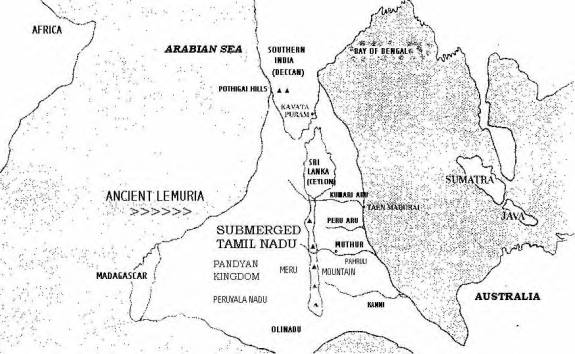
When we think of martial arts, we usually think of China or Japan. Only recently, people have discovered that martial arts had its roots in India “somewhere”. The location of what part of India martial arts came from still remains a mystery to a lot of people.
Let us take note that India is a sub-continent with roughly 18 languages and various dialects of certain languages. Each state has its own language and writing script. Moreover, there are three major ethnic groups which are the Indo-Aryans of the Northern part, the Mon-Khmer of the Eastern part, and the Dravidians (Thamizhars) of the Southern part. The Indian sub-continent is more comparable to Europe geographically even though it is a country in itself created by the colonial British for their own economical achievements.
Martial arts have been in existence on the Indian sub-continent for thousands of years practiced by ancient Tamils of Tamil Nadu, Tamil Eelam (Northeast Sri Lanka), Kerala, and the Southern portion of present day Andhra Pradesh. The Malayalam language in Kerala only separated from Tamil as its own language during the 8th century A.D. In Andhra Pradesh, the southern half of that state spoke Tamil, while the northern part spoke Prairie, before the language of Telungu had formed it’s own language in that state. In Sri Lanka, the whole island was Tamil up to the 3rd century B.C. before the arrival of a group of exiles from Bengal penetrated the island. They settled in the Southern and Western and Southern parts of the island. Their offspring later became the present day Sinhalese, which their language is a mixture of Tamil, Pali (from Bengal area), and Sanskrit.
The Indian sub-continent was once connected with Madagascar of East Africa and Australia by the sunken Lemurian continent of the Indian Ocean. On the African continent itself are numerous fighting styles some also in forms of dances which resemble various Kung-Fu kicks, leaps, and maneuvers. In Brazil, there is a martial art called Capoeira. It is a fighting style in a form of a dance brought to South America by slaves along with the Yaruba religion of West Africa. These ideas of combat must have crossed from both Africa and Australia through Lemuria to the Indian sub-continent which may have had an influence on the scientific Tamil martial arts thousands of years ago.
Long ago, animal fighting styles were imitated by pre-historic man which was a system for survival. The first weapon used was the stick which was an extension of the arm. Various weapons were later invented during the Stone and Iron Ages. At the turn of the 6th century A.D., martial arts spread from Southern India to China by a Tamil prince turned monk named Daruma Bodhidarma. From China, martial arts have spread to Korea & Japan. In South East Asia martial arts was introduced during the naval expansion of the Chola and Pallava Empires of the Tamil Country between the 2nd and 12th centuries A.D.
In the Tamil country, the earliest martial arts known were Varma Kalai (pressure point attacks – similar to Tai Chi or Dim Mak), Kuttu Varisai (hand to hand combat – similar to Kung Fu and Karate), Malyutham (wrestling), Silambam (staff and weapons fighting – similar to the Filipino arts of Arnis, Kali, and Escrima), and Adithada (kickboxing).
Martial arts can also be seen in the classical dance of Bharatha Natayam. Through its rhythmic movements one can see a close resemblance to the stances, blocks, and strikes in martial arts. There is also a close affiliation to Yoga in the stretching and meditating exercises of almost every fighting art.
Martial Art Misconceptions:
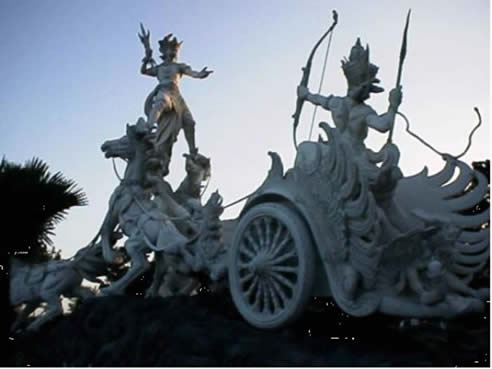
During the mid-1990’s the martial art of Kerala called Kalaripayattu began to gain popularity, especially in the tourist industry of Kerala. It was widely believed that the only martial art in India was Kalaripayattu, claiming to be the mother of all martial arts. In an Indo-U.S. monthly magazine called “India Currents” dated back in 1996, there was an article on Kalripayattu. It talked about a battle between the Cholas and Cheras where the Chera kingdom of Kerala were victorious in defeating the Cholas because of their knowledge in Kalaripayattu, thus “the they took to their heels and fled”.
The Cholas not having knowledge in the martial arts is absolutely FALSE. It was the fighting prowess of the Cholas, and their strategic military capabilities which allowed them to expand their empire as far north to the Ganges, as far west to the Maldives, as far south to the island of Sri Lanka, and as far east to Malaysia… In India there tends to be a trend to sideline Tamil culture, even in the martial arts. Kalaripayattu is not the only living martial art on the sub-continent. It is one of many.
Kalaripayattu became an established martial art during the 13th century AD as quoted in Frank Zarilli’s “When the Body Becomes All Eyes”. The art of Kalarippayattu is a dynamic fighting system which incorporates a combination of yoga and gymnastics. It trains in an array of weaponry, empty hand combat, pressure point attacks (Marma Adi), and the healing arts of Ayurveda. The Kerala dance of Katha Kali is very close to the martial art of Kalarippayattu in its posture, stances, and foot movements.
Another misconception is in which martial art the monk Daruma Bodhidarma had introduced to China. In many articles and web sites, it claims that Bodhidarma had studied and introduced Kalarippayattu to China. If Kalarippayattu had not been established until the 13th century A.D., then how would it have been possible for this art to have been introduced to China during the 6th century A.D. (700 years back)? Also, Bodhidarma was from Kanchipuram, Tamil Nadu where several martial arts there were already in existence.
In Partap Sharma’s book called ‘Zen Katha: Inspired by the Life of Bodhidarma, founder of Zen and Martial Arts’, it states that it was the art of Vajramushti Bodhidarma had introduced to Shaolin. Vajramushti is a fierce style of wrestling which has it’s origins in the state of Gujarat situated in Northwestern India. The only difference which sets it apart from modern day wrestling is that the contestants wore knuckledusters on their right hands to add devastating power to their one hit blows.
Vajramushti has its influences from Greek Prankrathon Wrestling during the time of Alexander the Great’s conquest of the Indus Valley and Northern India. This fighting style does not resemble Kung-Fu or Karate, nor does it incorporate any other weapon other than the knuckleduster.
Many people in the western world often relate martial arts with Buddhism due to its stereo type in Hollywood films. Well, it was Buddhism which was introduced from Northern India and martial arts from Southern India. There was a very brief period when Buddhism was practiced in the Tamil country of the Southern Indian peninsula.
So, what religion do martial arts belong to? Is it a Hindu art, a Buddhist art, or of some other religion? It would be irrelevant to say that martial arts came from any religion since martial arts was originally a system of survival for early man. Religions have incorporated martial arts into their realm. In the western part of the African continent martial arts is part in the Yaruba religion. The same can be said in Asia. However, if one were to say that Asian martial arts philosophies had its roots from Buddhism, it would be false. As far as the philosophical aspect of Asian martial arts, it has its roots in Hinduism.
Take for example the famous ‘Yin and Yang’ symbol. It represents a combination of opposites like hard and soft, light and dark, and male and female. The origin of Ying and Yang came from the male and female Hindu deities Siva and Shakti. In Bharatha Natayam, it is said that Siva was the creator of the dance. He is known as the Natarajah, or Lord of the Dance. Likewise, he was known for the creation of scientific martial arts and the healing arts like Varma Cuttiram. Other martial arts of the Tamil peninsula on the Indian sub-continent like Silambam is said to have its roots from Siva’s son, Murugan.
Even in the martial arts system of Kalarippayattu, its philosophies state that this art was created out of the wrath and fury of Siva when he destroyed the demon Dakshayaga. One of Siva’s disciples, Parasurama, is supposed to have studied this art from him and passed it on to his 21 disciples in Kerala.
Daruma Bodhidarma:
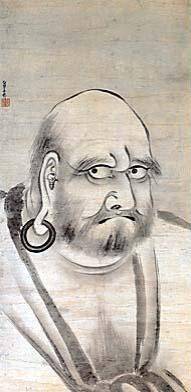 Daruma Bodhidharma (Chinese: Ta Mo; Japanese: Daruma) was the third child of the Pallava king Sugandan from Kanchipuram, Tamil Nadu. At birth he was born with a breathing disorder and was banished by his family due to the evil practice of caste system introduced by the Indo-Aryans who had migrated from Persia (present day Iran). He was adopted and trained at birth in breathing exercises and combat, namely in the arts of Varma Kalai and Kuttu Varisai. Bodhidarma also studied Dhyana Buddhism and became the 28th patriarch of that religion. Daruma Bodhidharma (Chinese: Ta Mo; Japanese: Daruma) was the third child of the Pallava king Sugandan from Kanchipuram, Tamil Nadu. At birth he was born with a breathing disorder and was banished by his family due to the evil practice of caste system introduced by the Indo-Aryans who had migrated from Persia (present day Iran). He was adopted and trained at birth in breathing exercises and combat, namely in the arts of Varma Kalai and Kuttu Varisai. Bodhidarma also studied Dhyana Buddhism and became the 28th patriarch of that religion.
When his master passed away, he wanted to spread his apprenticeship to other countries and moved to China. After having met emperor Wu-Di of the Liang dynasty, he settled down in the Shaolin Monastery, which is situated in the province of Henan (northern China). In the monastery, Bodhidharma lived ascetically and by meditating for 9 years developed Ch'an Buddhism (Japanese: Zen Buddhism).
When he taught Ch'an Buddhism, which contains elements of Dhyana Buddhism and Taoism, he realized that his apprentices did not have the mental and physical shape to really meditate, or to defend themselves from bandits. That's why he developed certain gymnastics and breathing techniques. Bodhidarma’s "muscle exercises" were surely influenced by his experiences with his experience in the Tamil martial arts. The "muscle exercises" and the "18 hands of lohan", which were developed later on, are however the basis for nowadays Shaolin Kempo, otherwise known as Kung Fu.
Bodhidarma also introduced the healing art of Varma Cuttiram and herbal medicines from the Tamil country which evolved into Acupuncture, Tai Chi Chuan, Qi Gong, and Chinese medicine of today.
Varma Kalai and Kuttu Varisai:
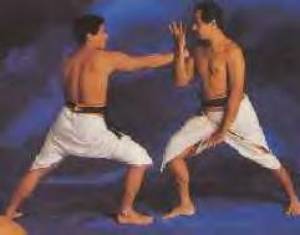 Both Varma Kalai and Kuttu Varisai combined make up a deadly fighting art. Varma Kalai (also known as Marma Adi in Kerala) is the art of dealing with vital pressure points of the human body. The Chinese arts of Tai Chi (healing touch) and Dim Mak (death touch) are very close to Varma Cuttiram (healing touch and remedies) and Varma Kalai. In Varma Kalai one can heal, maim or even kill someone depending on what part of the body is hit and how much pressure is applied. Both Varma Kalai and Kuttu Varisai combined make up a deadly fighting art. Varma Kalai (also known as Marma Adi in Kerala) is the art of dealing with vital pressure points of the human body. The Chinese arts of Tai Chi (healing touch) and Dim Mak (death touch) are very close to Varma Cuttiram (healing touch and remedies) and Varma Kalai. In Varma Kalai one can heal, maim or even kill someone depending on what part of the body is hit and how much pressure is applied.
In Kuttu Varisai, gymnastic, stretching (yoga), and breathing exercises are conducted before training. In combat, almost every part of the body is used such as the fists, elbow, feet, knees, etc. Various different animal styles such as the tiger, elephant, snake, eagle and 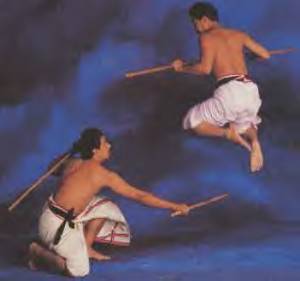 monkey are used. All these styles include posture, grappling, throws, hits, and locks. monkey are used. All these styles include posture, grappling, throws, hits, and locks.
There are a huge variety of weapons used in this fighting system which can easily be seen in many Chola bronze statues of various deities. Some resemble those used by the gladiators of ancient Rome. Weapons include the trident, sticks (kali or kaji) (short, long, or double sticks), swords (val) and shield, double swords, daggers (kuttuval) (simple or double), knuckle duster (kuttu katai), and whips with several flexible and metallic blades (surul pattai).
Silambattam (Silambam):
Silambam is an ancient art of staff fencing. This was patronized by the Chola, Chera and Pandiya Kings, who ruled the country of Tamilnadu and other parts of the sub-continent.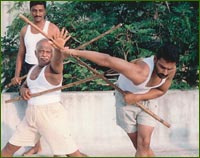 According to research this form of martial arts has been in existence for over 5000 years, even before the arrival of the Indo-Aryans. Silambam is said to be the oldest in the world since the use of the stick was the first weapon used in pre-historic times. It received royal patronage from all the Tamil Kings beginning from the sangam era. The soldiers of the King Veerapandia Kattbomman (1760 – 1799) relied mainly on their prowess in Silambam in their warfare with the British Army. According to research this form of martial arts has been in existence for over 5000 years, even before the arrival of the Indo-Aryans. Silambam is said to be the oldest in the world since the use of the stick was the first weapon used in pre-historic times. It received royal patronage from all the Tamil Kings beginning from the sangam era. The soldiers of the King Veerapandia Kattbomman (1760 – 1799) relied mainly on their prowess in Silambam in their warfare with the British Army.
The Silappadikkaram of Tamil literature, dating back to 2nd century A.D., refers to the sale of Silamabam staves, swords, pearls and armor to foreign traders. The ancient trading centre at Madurai city, renowned globally, was said to be thronged by Romans, Greeks, and Egyptians among others who had regular sea trade with the ancient Dravidian kings. The silambam staff was one of the martial art weapons, which was in great demand with the visitors.
Some records trace the origin of this art to the Tamil deity Murugan. Silambam is believed to have traveled from Tamil Nadu to Malaysia, where it is now a popular recreational sport and also a mode of self - defense.
Four different types of staves are used. One produces a swishing sound, another involves lighted balls of cloth at one end of the staves, called 'torch silambam', a third is quite short in length but powerful, and finally a non - elastic staff that produces a clattering sound.
Malytham (Grappling):
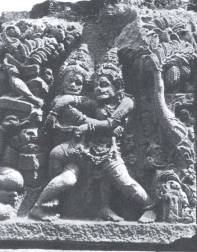 Malyutham is similar to western wrestling. Greek Pankrathon wrestling may be related to this art since there have been much sea-trade between the Tamil country, Greece and Rome (yavanas). The art reached its zenith in Tamilnadu during the Pallava period. The temples of Mamalapuram were constructed by the Pallava king Mammala. He is said to have been a master at Malyutham wrestling. During mid-Chola period mallas ( artistes ) went to various parts of the sub-continent and Sri Lanka to participate in tournaments. The art was taught in ancient days by persons belonging to the Malliga Chetty community. Malyutham is similar to western wrestling. Greek Pankrathon wrestling may be related to this art since there have been much sea-trade between the Tamil country, Greece and Rome (yavanas). The art reached its zenith in Tamilnadu during the Pallava period. The temples of Mamalapuram were constructed by the Pallava king Mammala. He is said to have been a master at Malyutham wrestling. During mid-Chola period mallas ( artistes ) went to various parts of the sub-continent and Sri Lanka to participate in tournaments. The art was taught in ancient days by persons belonging to the Malliga Chetty community.
Here, the opponents wrestle with each other, attempting to push the other down. Various rules of the game apply to the procedure. In a tournament, wrestlers travel far and wide, challenging local wrestlers, and if they win, the name and fame of their own town or area is multiplied hundredfold.
Adithada (Kick Boxing):
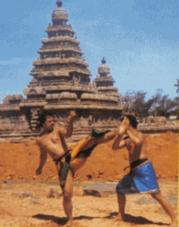 Adithada is very similar to Muay Thai kickboxing. Fighters use their feet, hands, knees, elbows, and the forehead. Grappling is incorporated as part of combination moves in this fighting art for take downs. Pressure points are also targeted during dueling. This art has evolved into a dynamic fighting sport in Thailand called Muay Thai and other countries of Indo-China like Cambodia, Laos, and Burma. During the British Raj, it was the Gurka regiment who used the Brumese martial art called Bando which incorporated kickboxing in this system called Lethwei. This art of kickboxing was also used by the Gurkas in hand to hand combat against the Japanese on the Indo-Burma border during WWII. Adithada is very similar to Muay Thai kickboxing. Fighters use their feet, hands, knees, elbows, and the forehead. Grappling is incorporated as part of combination moves in this fighting art for take downs. Pressure points are also targeted during dueling. This art has evolved into a dynamic fighting sport in Thailand called Muay Thai and other countries of Indo-China like Cambodia, Laos, and Burma. During the British Raj, it was the Gurka regiment who used the Brumese martial art called Bando which incorporated kickboxing in this system called Lethwei. This art of kickboxing was also used by the Gurkas in hand to hand combat against the Japanese on the Indo-Burma border during WWII.
Tamil Martial Arts in Southeast Asia:
Between the 2nd to 12th centuries AD the Cholas and Pallavas did extensive sea trade throughout Southeast Asia and China. Various countries periodically came under Tamil rule. At the beginning of the 2nd century AD, Pallava prince Kaundinyan of Kanchipuram became the first king of Cambodia. Much of the historical accounts of the time can be seen in bas reliefs (carvings on walls similar to Mamallapuram wall carvings) 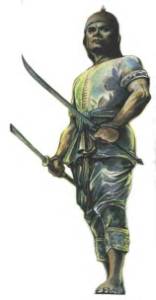 at sites like the Angkor Wat and Angkor Thom. The fighting arts and styles can be clearly seen on these walls. At the Prambanan and Borobodur temples of Java Indonesia the same can be seen in the bas reliefs of the Tamil martial arts fighting skills used by ancient warriors. During the 10th century A.D. the Chola Empire was at its peak with their expansion in Southeast Asia. Under king Raja Raja Chozhan parts of Burma, Isthmus of Kra, Malaysia, Sumatra, and Java were under his rule. at sites like the Angkor Wat and Angkor Thom. The fighting arts and styles can be clearly seen on these walls. At the Prambanan and Borobodur temples of Java Indonesia the same can be seen in the bas reliefs of the Tamil martial arts fighting skills used by ancient warriors. During the 10th century A.D. the Chola Empire was at its peak with their expansion in Southeast Asia. Under king Raja Raja Chozhan parts of Burma, Isthmus of Kra, Malaysia, Sumatra, and Java were under his rule.
Much of the elements of Tamil culture introduced there were dance, cuisine, writing, literature, architecture, and the martial arts. Here is a list of fighting systems in each Southeast Asian country which had its roots in Varma Kalai, Kuttu Varisai, Malyutham, Adithada and Silambam.
- BURMA – Bando, Lethwei (kickboxing)
- THAILAND – Krabi Krabong, Muay Thai (kickboxing)
- CAMBODIA – Pradal Serey (kickboxing)
- MALAYA – Bersilat, Silambam
- INDONESIA – Pentjak Silat (styles vary from island to island)
- PHILIPPINES – Arnis - Kali – Escrima (stick, knife, and machete fighting), Sikaran (kickboxing), and Dumog (wrestling)
Conclusion:
In conclusion to this topic, Martial arts were introduced by the Tamil civilization to China and Southeast Asia. Proof of the Tamil navy venturing into Southeast Asia introducing various arts can be seen on the bas reliefs of numerous temples in places like Cambodia and Indonesia. The ancient city of Kanchipuram where Daruma Bodhidharma was born is located no where else other than in Tamil Nadu. The fact that there are similar martial arts on the African continent which was brought to Brazil from West Africa also proves the fact of the origination of the Thamzhars and other Davidians through the Lemurian continent. The martial arts of Varma Kalai, Kuttu Varisai, Silambam, Malyutham, and Adithada have been in existence for thousands of years. However, the martial arts of the Tamils are slowly vanishing. Anyone who is interested in joining a discussion group to learn, teach, and promote these arts are welcome. Please go to: Thamizhar Martial Arts http://sports.groups.yahoo.com/group/thamizharmartialarts/
Sources:
- Sharma, Pratap Zen Katha: Inspired by the Life of Bodhidarma, founder of Zen and Martial Arts
- Zarilli, Phillip When the Body Becomes all Eyes
- Encyclopecia of Martial Arts
- Broughton, Jeffrey The Bodhidarma Anthology
- Hsuan, Hua The Intention of Patriarch Bodhidarma’s coming from the West
- Balakrishnan, P. Kalarippayattu
- Madras Institute of Asian Studies Varma Cuttiram
- Raj, Manuel J. Silambam: Technique and Evaluation
- Raj, Manuel J. The origin and the historical development of Silambam fencing[microform] :an ancient self-defense sport of India
- New Delhi: Sports Authority of India Indigenous Games and Martial Arts of India
- International Tamil Language Foundation The Handbook of Tamil Culture and Heritage
- Winderbaum, Larry The Martial Arts Encyclopedia
- Ramaswamy, Sumathi The Lost Land of Lemuria: Fabulous Geographies, Catastrophic Histories
- Lewis, J. Lowell Ring of Liberation: Deceptive Course in Brazilian Martial Arts
- Capoeira, Nestor Capoeira: Roots of the Dance-Fight Game
- Kraithat, Panya Muay Thai: The Most Distinguished Art of Fighting
- Vaitayanon, Kumron Muay Thai: The Art of Eight Limbs
- Paladin Press Fighting Arts of Indonesia: Combat Secrets of Silat and Kuntao
- Wiley, Mark V. Filipino Martial Arts: Cabales Serrada Escrima
- Galang, Reynaldo S. Classic Arnis
- Diego, Antonio The Secrets of Kalis Ilustrisimo
- Berk, William R. Chinese Healing Arts
- Varmakalai http://perso.wanadoo.fr/varmakalai/VARMA%20KALAI%20-%20(ENGLISH)%201.htm
- Silambam www.silambam.com
|
 Home
Home Archives
Archives Home
Home Archives
Archives